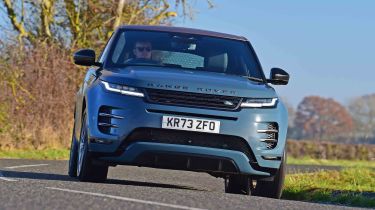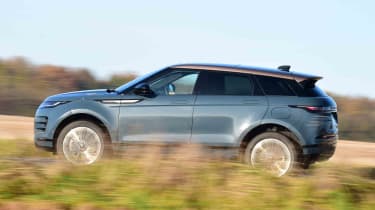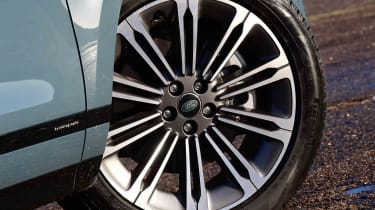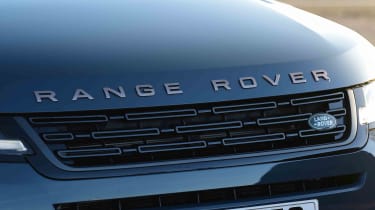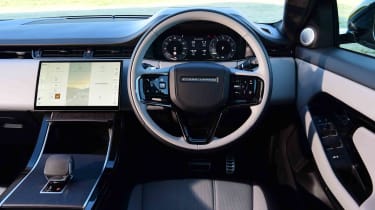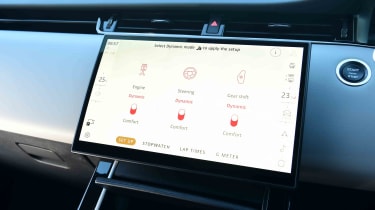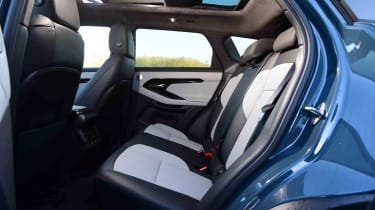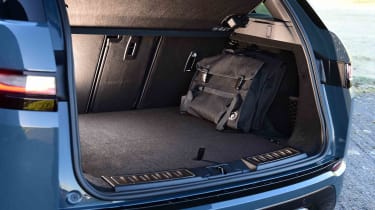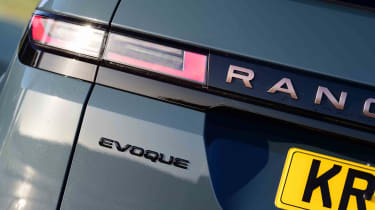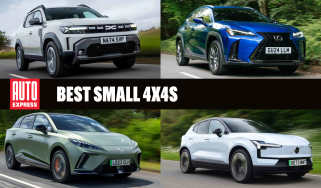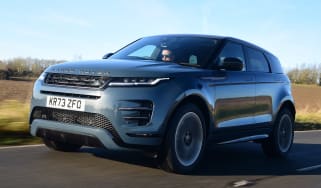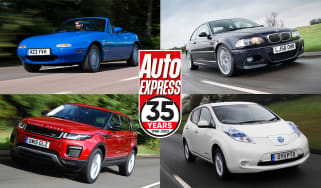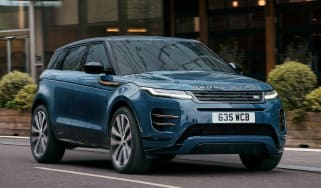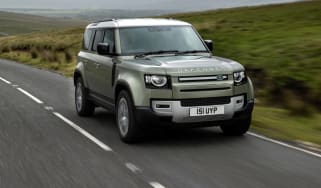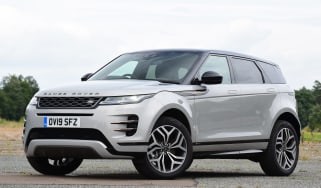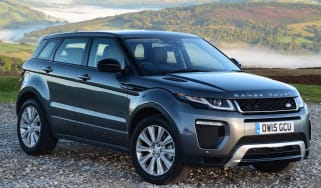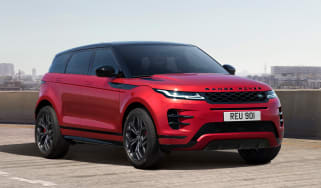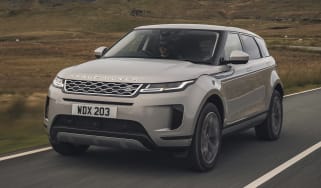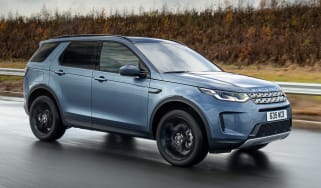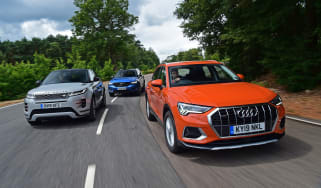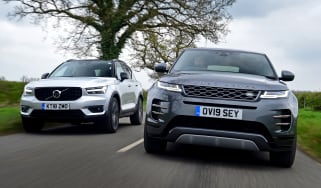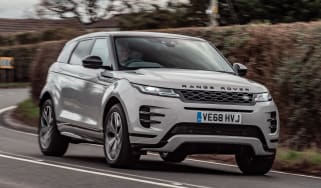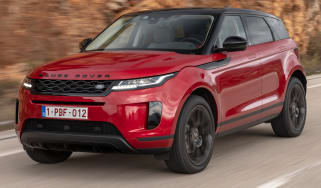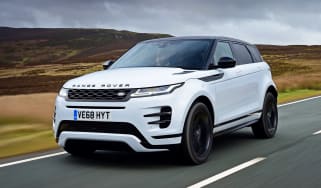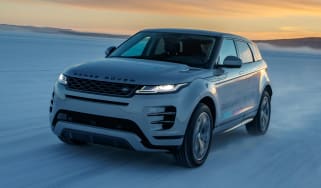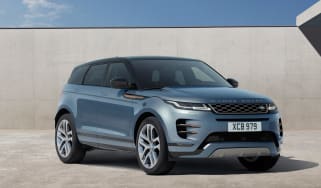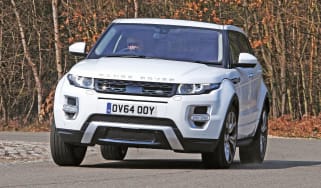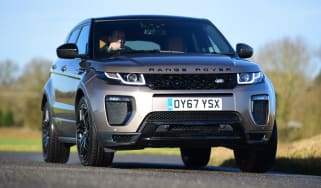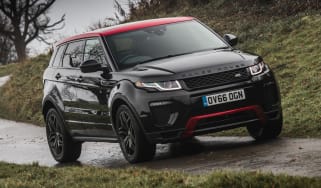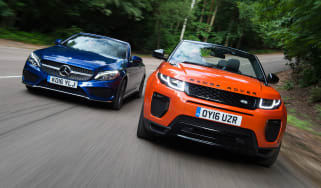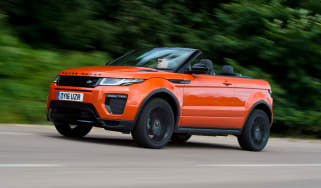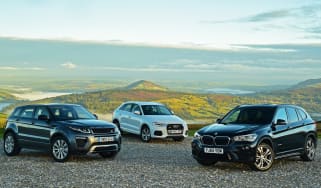Range Rover Evoque review
The Range Rover Evoque offers great levels of luxury, technology and – perhaps most importantly – style

Our opinion on the Range Rover Evoque
Although the current Range Rover Evoque doesn’t look too far removed from the first-generation model, it’s added impressive levels of technology, a range of mild and plug-in hybrid powertrains, plus all the refinement and premium touches you’d expect of the larger Range Rover models.
The standard equipment list is generous, while higher-spec models bring full-fat Range Rover appointments. The Benefit-in-Kind savings for business users will make the plug-in hybrid version particularly appealing, although it cannot match the savings of an electric SUV.
About the Range Rover Evoque
While some premium compact SUV rivals such as the BMW X1 offer a more engaging driving experience, the Evoque provides a focus on luxury and comfort that many buyers will prefer. More than a few Evoques will have sold because of their bold looks or the Range Rover name alone, but that’s not to say this car isn’t a viable alternative to favourites like the Audi Q3, Volvo XC40 or Mercedes GLA.
The Evoque is the smallest Range Rover model that Land Rover produces and in its original form – introduced in 2011 – it was a car that set a precedent as a small yet luxurious SUV aimed squarely at a niche in the market (especially the previous-generation convertible and three-door models).
Used - available now

2026 Land Rover
Range Rover Evoque
13,365 milesAutomaticDiesel2.0L
Cash £34,995
2020 Land Rover
Range Rover Evoque
71,242 milesAutomaticDiesel2.0L
Cash £16,853
2019 Land Rover
Range Rover Evoque
56,635 milesManualDiesel2.0L
Cash £11,733
2023 Land Rover
Range Rover Evoque
26,835 milesAutomaticPetrol1.5L
Cash £24,428While the Evoque uses the same platform as the Land Rover Discovery Sport, it doesn't share its sibling's more practical seven seat option (only on diesel models). It does, however, use the same 48-volt mild hybrid and plug-in hybrid technology to improve efficiency and reduce emissions.'
Range Rover Evoque prices and latest deals
Prices currently start from a little over £44,000 for an entry-level car with the less-powerful diesel powertrain. If you’re considering the PHEV, you’ll be looking at at least £49,110. It’s also quite easy to add thousands to the price when you start delving into the options list, so we’d advise listening to your head rather than going with your heart.
You can enjoy some healthy savings if you spec your perfect Range Rover Evoque through the Auto Express Buy a Car service, though, as we offer average savings of £3,011. You can also find plenty of used Range Rover Evoques at some seriously tempting prices.
Performance & driving experience
Pros |
|
Cons |
|
Just like its full-sized sibling, the Range Rover Evoque treads a careful line between being a comfortable, mile-munching commuter and a rugged off-roader.
It’s unlikely many Evoques will actually venture off-road, but being a Land Rover product, the car does boast impressive skills when the going gets rough. The wading depth has increased from 500mm with the old car to 600mm for the latest model, while Land Rover’s Terrain Response 2 system can automatically adjust the Evoque’s behaviour to suit the conditions at hand. The supplied Comfort, Sand, Grass-Gravel-Snow, and Mud and Ruts settings can also be selected manually, too.
| Model | Power | 0-62mph | Top speed |
| Evoque P270e | 265bhp | 7.2 seconds | 118mph |
| Evoque P160 | 162bhp | 10.3 seconds | 124mph |
| Evoque D200 | 201bhp | 8.5 seconds | 132mph |
Performance, 0-60mph acceleration and top speed
The Range Rover Evoque comes with the choice of either a mild-hybrid petrol engine, two mild-hybrid diesels, or a plug-in hybrid set-up. Every powertrain is mated to a nine-speed automatic gearbox, while all come with four-wheel drive, except the petrol version.
The entry-level D165 2.0-litre turbocharged diesel produces 161bhp and manages a 0-62mph time of 9.8 seconds. The more powerful diesel is the 201bhp D200, and that cuts the 0-62mph time to 8.5 seconds.
The sole petrol Evoque now on sale is the P160, which consists of a 1.5-litre turbocharged three-cylinder engine with 162bhp and a 0-62mph time of 10.3 seconds.
For those seeking maximum performance from the Evoque, you’ll need to look at either the P270e plug-in hybrid. This variant features a 1.5-litre three-cylinder petrol engine working in tandem with an electric motor to deliver a combined 265bhp. The PHEV is certainly no slouch, reaching 62mph from a standstill in 7.2 seconds.
Town driving, visibility and parking
Unsurprisingly, one of the biggest advantages of choosing the Evoque is that it’s much less ungainly when being manoeuvred through the chaotic city streets. Its small exterior dimensions make parking less of a chore, but we find the slim rear windscreen restricts visibility. If you’re prepared to fork out for the £585 optional 360-degree camera (standard-fit on the Dynamic SE and Autobiography trims), this helps to alleviate the issue.
Country road driving and handling
Unlike its now-defunct JLR stablemate, the Jaguar E-Pace, the Range Rover Evoque hasn’t been designed to offer outright thrills to its driver. On a twisty country road, there’s a bit of body lean in tight bends, some slack in the steering at the straight-ahead position, and less front end grip than that of the Jaguar.
The trade-off between body control and ride quality seems well-judged, though, particularly in regular petrol and diesel versions. The extra weight of the battery pack in the plug-in hybrid version is noticeable when driven a little more aggressively, but never to the point that it feels like it’ll get out of shape.
Motorway driving and long-distance comfort
Once you get the Evoque onto the motorway, it comes into its own. Here, the refinement and comfort levels on offer have taken a big step forward from those of the old car; Land Rover’s engineers have made sure that the Evoque is a cosseting cruiser rather than a sports car in an SUV body. In this respect, the Evoque compares favourably with the Volvo XC40, a small SUV with a similar outlook on life. Even on the largest 21-inch wheels, ride quality is excellent.
"For a Range Rover, the Evoque is excellent at nipping around town with its tight and responsive handling, although nabbing a steering wheel from its bigger brothers seems unnecessary." - Alastair Crooks, senior news reporter.
MPG & running costs
Pros |
|
Cons |
|
Starting with the diesels, the less-powerful D165 has a quoted WLTP CO2 emissions figure of 174g/km, with average WLTP fuel economy of up to 44.6mpg. The D200 can also return 44.6mpg, but it churns out up to 180g/km of CO2.
The P160 petrol emits a bit more CO2 and returns slightly worse fuel economy figures than its diesel counterparts. These figures sit at 183g/km of CO2 and 32.6mpg. However, for company car drivers, you’ll want to look towards the plug-in hybrid models because these provide the biggest tax savings.
If you’re not a company car driver, we recommend the D200 diesel as the best all-rounder for performance, economy and emissions.
| Model | MPG | CO2 | Insurance group |
| Evoque S P160 | 35.9 | 178 | 25 |
| Evoque Autobiography P270e | 192.9 | 32 | 38 |
| Evoque Dynamic SE D200 | 43.6 | 170 | 31 |
Electric range, battery life and charge time
The Evoque PHEVs are able to travel up to 38.5 miles on electric charge alone, although this does fall short of the BMW X1 eDrive 20’s 54-mile range. The official fuel economy figure stands at 201.8mpg, but in our experience of plug-in hybrid cars, you’ll be hard-pressed to match these figures in real-world driving.
When you do need to top it up, the plug-in Evoque is quite unique in this class for its rapid charging capability. It can accept up to 32kWs of charging, meaning you can refill its battery from zero to 80 per cent in just 30 minutes. However, we wouldn’t recommend doing this often because it’s quite an expensive way to top up an Evoque. Instead, we’d suggest you do it via a wallbox charger at home using cheaper overnight electricity. Doing it this way will take about two and a half hours for a full 100 per cent charge using a typical 7.4kW charger.
| Model | Battery size | Range | Insurance group |
| Evoque S P270e | 15kWh (12.7kWh usable) | 38.5 miles | 34 |
| Evoque Dynamic SE P270e | 15kWh (12.7kWh usable) | 35.3 miles | 35 |
| Evoque Autobiography P270e | 15kWh (12.7kWh usable) | 37.9 miles | 38 |
Insurance groups
The Range Rover Evoque starts in insurance group 25 for the petrol variant in entry-level S trim, climbing through groups 26 to 34 for the same-spec D160, D200 and P270e, respectively. Moving up the trim levels also impacts the applicable insurance group, with the range-topping Autobiography PHEV residing in group 38.
By contrast, the BMW X2 starts in group 25 in the basic sDrive20i Sport form, while the performance-oriented X2 M35i has a group 35 rating. The Volvo XC40, meanwhile, sits in groups 23 to 30.
It’s likely that the cachet of that Range Rover badge might have something to do with the Evoque’s higher rating versus its rivals, although there have been some historic issues with Land Rover owners getting insurance coverage for their cars.
Check if your car needs an MoT and view its complete history with our MoT History Checker...
Tax
The Range Rover Evoque is undoubtedly an upmarket SUV, but unfortunately, its near-£45,000 starting price pushes the whole line-up over the £40,000 luxury car tax threshold. This means owners will have to pay a total of £620 annually from years two to six.
Company car drivers will see a reduced 12 per cent Benefit-in-Kind (BiK) rate if they opt for the plug-in hybrid model. However, this still doesn’t come close to the three per cent rate offered by fully electric cars.
Depreciation
Our experts predict that the latest Range Rover Evoque should hold onto between 51 to 56 per cent of its value after three years and 36,000 miles, with the diesel models being the best performers. The Evoque's depreciation figures aren’t too dissimilar from the BMW X1’s 51 to 54 per cent, nor the Mercedes GLA’s 49 to 58 per cent.
To get an accurate valuation on a specific model check out our free car valuation tool...
Interior, design & technology
Pros |
|
Cons |
|
The current Range Rover Evoque received an evolutionary styling update rather than a drastic one. In other words, Land Rover chose not to break what worked so well for the original car. The second-generation Evoque is less aggressive, taking inspiration instead from the larger Range Rover Velar, with similar headlights, taillights, and smoothed-off flanks with smart recessed door handles. R-Dynamic models bring a sportier look, adding black and burnished copper detailing plus a body-coloured front bumper.
There are plenty of alloy wheel designs to pick from, ranging from 18 to 21 inches as standard, depending on spec. A palette of silvers, greys, and blacks makes up most of the Evoque’s paint choices, with Corinthian Bronze being a notable exception. Fuji White is the only standard paint, Metallic paint costs £705 while premium metallic paint is £970.
Interior and dashboard design
Inside the Evoque, you’ll find further similarities with the Range Rover line-up, with a focus on quality materials, clean design and modern infotainment.
However, the separate screen with its easy-to-use dials has gone, merged into the large 11.4-inch touchscreen just like on the XC40. This is a backwards step in our view because it’s taken something that allowed the Evoque to stand out against its rivals in terms of ease of use, and given us a ‘solution’ that makes it just as hard to adjust the air-con on the move as its competitors. Plus, the rotary dials had a clever dual purpose that allowed you to adjust the heated front seats with them, too. Now, you’ve got to delve into the screen to do this task.
There’s plenty of scope for personalisation inside, with various colour combinations, equipment packs and trim finishes, but you should be prepared to pay handsomely to add these individual touches.
Standard kit includes a 10-inch touchscreen running Land Rover's Pivi infotainment system, wireless Apple CarPlay and Android Auto smartphone connectivity, a reversing camera, cruise control, lane-keeping assist and 17-inch alloy wheels. Higher-spec models get an upgraded Pivi Pro infotainment system, a Meridian sound system, leather upholstery and larger rims, among other luxuries.
As you might expect, there are plenty of options packs, too. The £580 optional convenience pack available from the entry-level Evoque S model adds keyless entry, an electric tailgate, and automatic high-beam assistance. There’s also the Comfort pack, which adds a UV and infrared reflecting windscreen, a fancier cabin air purification system, a couple of air vents in the back, and configurable ambient interior lighting.
Materials and build quality
Overall interior quality has taken a welcome step forward and is now on a par with rivals from the likes of Audi and Volvo. In fact, it feels slightly ahead of the Volvo XC40, with a greater focus on outright luxury.
Infotainment, sat-nav and stereo
The Evoque features Land Rover's Pivi Pro on-board tech, which includes a 11.4-inch touchscreen, a DAB digital radio, and wireless Apple CarPlay and Android Auto connectivity. The menu layout is straightforward, and the system can now be upgraded via over-the-air updates. Simply put, Land Rover’s Pivi Pro infotainment system is a quantum leap compared with the old set-up featured in pre-2021 Evoques.
“The brand’s latest Pivi Pro operating system is superb. The menus are easy to navigate, and it doesn’t feel like there are too many unnecessary steps to find key functions.” - Alastair Crooks, senior news reporter.
Boot space & practicality
Pros |
|
Cons |
|
The Range Rover Evoque may look much like the old car to the untrained eye, but with just a few Range Rover Velar-inspired tweaks, it’s been brought right up-to-date. The Evoque has a longer wheelbase than before to free up more rear passenger space, but that sloping roofline still poses an issue for taller occupants.
In the front, a good driving position is easily found using the standard electrically adjustable front seats and driver memory settings. All versions come with heated front seats.
We find that rearward visibility is hampered by a narrow rear window and slim glasshouse, but the optional ClearSight rear-view mirror and 360-degree surround camera system (both standard on Autobiography) help with this issue. The former uses a roof-mounted camera to display an uninterrupted, widescreen view of the road behind or – at the push of a button – can be returned to a conventional mirror. Parking sensors front and rear are standard.
There are four generously sized storage bins, a large cubby under the centre front armrest, and a useful rubberised tray on the centre console that’ll easily store a phone or wallet; the cupholders are located beneath it.
Dimensions and size
The Range Rover Evoque measures 4,371mm long, 1,649mm tall and 1,996mm wide (2,100mm including mirrors). For comparison, the Volvo XC40 is a few millimetres taller and longer, but a shade narrower at 1,910mm wide (excluding side mirrors).
| Dimensions comparison | |||
| Model | Range Rover Evoque | Volvo XC40 | BMW X1 |
| Length | 4,371mm | 4,425mm | 4,500mm |
| Width | 1,996mm | 1,910mm | 2,104mm |
| Height | 1,649mm | 1,652mm | 1,642mm |
| Wheelbase | 2,681mm | 2,700mm | 2,692mm |
| Boot space | 472-1,156 litres | 443-1,319 litres | 500-1,545 litres |
Seats & passenger space
There’s enough space in the Evoque to sit one six-footer behind another, but despite a small increase in leg room over the original car, the rear-seat occupant will still feel a little hemmed in.
Longer journeys may become uncomfortable for adults in the rear. This is because the tapered rear reduces the interior width, so sitting three abreast will prove pretty cosy. The sloping roofline will annoy anyone much over six feet tall. The Volvo XC40 does a much better job of rear-seat packaging.
A pair of ISOFIX child seat mounts are fitted to the outer positions of the rear bench.
Boot space
In the boot, there is 472 litres of space on offer with the seats up, which isn’t particularly outstanding compared to rivals. For example, BMW quotes 500 litres for the X1 and Lexus 545 litres for its Lexus NX. Thanks to clever packaging, however, boot space doesn’t change for the plug-in hybrid model.
Fold the seats down, and there is 1,156 litres of space to play with. The rear seats fold on a 40:20:40 split via a handle in the boot. In true Land Rover tradition, there’s a huge selection of practicality-boosting accessories to add – including seat-back stowage, a rubber mat for the boot and a rear bumper protection cover for when loading.
Towing
The Evoque lives up to its badge when it comes to towing. There’s a choice of an electrically deployable tow bar or a detachable item, along with Land Rover’s Advanced Tow Assist, which helps demystify the dark art of reversing a trailer using the rear view camera.
All but the petrol Evoque are rated to tow an unbraked trailer of up to 750kg. Choosing a diesel model will see the best braked towing capacity at up to 2000kg. The PHEV sees this figure drop down to 1,600kg, while the entry-level petrol with front-wheel drive is not rated to tow.
Now that it’s only available as a mild-hybrid petrol, the Volvo XC40 is also rated to tow a maximum of 1,600kg.
“You wouldn’t call the rear particularly dark and dingy, but the enormous sliding panoramic that is standard on the Autobiography helps make it much more airy.” - Alastair Crooks, senior news reporter.
Reliability & safety
Pros |
|
Cons |
|
The Evoque was tested by Euro NCAP in 2019 and achieved a maximum five-star overall rating, with a 94 per cent score for adult occupant safety and 87 per cent for child passenger protection.
All models come as standard with a reversing camera, front and rear parking assistance, lane-keeping assist, automatic emergency braking (AEB), a driver condition monitor and cruise control with a speed limiter.
Safety kit includes adaptive cruise control, an intrusion sensor, child locks, six airbags, a deployable bonnet with a pedestrian airbag, and a traffic sign recognition with an adaptive speed limiter. Dynamic SE models and above get blind spot assistance and a rear traffic monitor.
When the Evoque last appeared in our Driver Power best cars to own results in 2023, it finished in a rather disappointing 72nd out of 75 cars. Reliability, cost of ownership, and exterior bodywork quality were all areas of concern, as was the infotainment system.
Land Rover has been making efforts to improve its reputation, though, and this appears to be working as the brand ranked in a respectable fifth out of 32 brands in our 2025 best manufacturer rankings. This was a better performance than several rivals, including BMW (8th) and Volvo (13th).
The Evoque is subject to the same warranty as other Land Rover products: three years with unlimited mileage. It does beat the standard three-year/60,000-mile warranties you’ll get from Audi and Volvo, but it isn’t quite as generous on time as some rivals, including Lexus, with up to 10 years of cover.
The battery pack in PHEV models is only guaranteed for six years or 60,000 miles, which is also a tad stingy considering the vast majority of its plug-in hybrid rivals have cover for up to eight years or 100,000 miles.
Every Evoque has a service schedule of two years or every 21,000 miles – whichever comes soonest. Land Rover includes a two-year parts warranty on all its servicing and maintenance work, and offers service plans for its cars. Prices are fixed at a sign-up price for their whole duration, with buyers given the choice of spreading the cost or making a one-off payment.
| Euro NCAP safety ratings | |
|---|---|
| Euro NCAP safety rating | Five stars (2019) |
| Adult occupant protection | 94% |
| Child occupant protection | 87% |
| Vulnerable road user protection | 72% |
| Safety assist | 73% |
Buying and owning
- Best buy: Evoque Dynamic SE D200
While it does require a little more investment, we recommend opting for the more powerful D200 diesel-powered Evoque in mid-range Dynamic SE trim. The PHEV carries the highest efficiency figures, but it also adds to the price, so we wouldn’t necessarily spring for it unless you’re a company car driver who wants to enjoy some tax savings. The diesel still returns over 40mpg along with a decent helping of performance.
Dynamic SE trim adds some extra luxuries to this premium SUV, along with some highly useful kit that includes a 360-degree camera, a powered tailgate, and an uprated Meridian sound system.
Range Rover Evoque alternatives
While few small SUVs can match the Range Rover Evoque for its off-roading ability, there are a number of other premium small SUVs to choose from. For those who fancy a bit of sporting flair, the BMW X1 boasts plenty of driving characteristics that are befitting of its badge. Meanwhile, those who are more comfort-oriented may be tempted by the Volvo XC40, Lexus NX, or Mercedes GLA.
Range Rover Evoque history
Range Rover Evoque Mk1: 2011-2018
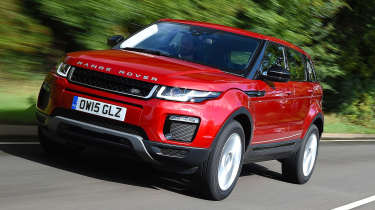
Based on the 2008 Land Rover LRX Concept, the first generation Evoque was launched in 2011 with three- and five-door models available. It won our Car of the Year award during its debut year, while its impressive engineering and well-penned styling have meant even older models still look modern and fresh today.
Diesel-engined Evoque's should be in good supply, while you might want to keep an eye out for the facelifted car, which arrived in 2015 with updated exterior styling, more efficient engines, revised tech and improved safety features. And, if you're after top-down, wind-in-your-hair driving fun, but with that familiar high-riding SUV driving position, there is the ultra-rare convertible model to consider. Read our full Mk1 Range Rover Evoque buyer’s guide here…
Frequently Asked Questions
If you’re after a nicely finished, refined, and comfortable SUV that’s easier to park than a full-size Range Rover, then the Range Rover Evoque will fit the bill.
Deals on the Evoque and alternatives
